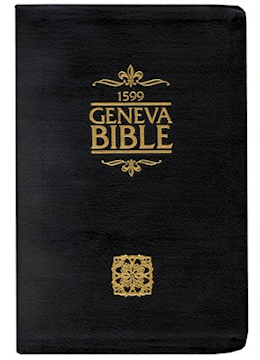Textus Receptus Bibles
Geneva Bible 1560/1599
| 4:1 | And hee made an altar of brasse twentie cubites long, and twentie cubites broade, and ten cubites hie. |
| 4:2 | And he made a molten Sea of ten cubites from brim to brim, rounde in compasse, and fiue cubites hie: and a line of thirtie cubites did compasse it about. |
| 4:3 | And vnder it was ye facion of oxen, which did compasse it rounde about, tenne in a cubite compassing the Sea about: two rowes of oxen were cast when it was molten. |
| 4:4 | It stoode vpon twelue oxen: three looked toward the North, and three looked towarde the West, and three looked towarde the South, and three looked towarde the East, and the Sea stoode about vpon them, and all their hinder parts were inwarde. |
| 4:5 | And the thickenesse thereof was an hande breadth, and the brim thereof was like the worke of the brim of a cuppe with floures of lilies: it conteined three thousand baths. |
| 4:6 | He made also ten caldrons, and put fiue on the right hand, and fiue on the left, to wash in them, and to clense in them that which apperteined to the burnt offrings: but the Sea was for the Priests to wash in. |
| 4:7 | And he made ten candlestickes of golde (according to their forme) and put them in the Temple, fiue on the right hand, and fiue on the left. |
| 4:8 | And he made ten tables, and put them in the Temple, fiue on the right hand, and fiue on the left: and he made an hundreth basens of golde. |
| 4:9 | And he made the court of the Priests, and the great court and doores for the court, and ouerlayd the doores thereof with brasse. |
| 4:10 | And he set the Sea on the right side Eastward toward the South. |
| 4:11 | And Huram made pottes and besoms and basens, and Huram finished the worke that hee shoulde make for King Salomon for the house of God, |
| 4:12 | To wit, two pillars, and the bowles and the chapiters on the top of ye two pillars, and two grates to couer the two bowles of the chapiters which were vpon the toppe of the pillars: |
| 4:13 | And foure hundreth pomegranates for the two grates, two rowes of pomegranates for euery grate to couer the two bowles of the chapiters, that were vpon the pillars. |
| 4:14 | He made also bases, and made caldrons vpon the bases: |
| 4:15 | And a Sea, and twelue bulles vnder it: |
| 4:16 | Pottes also and besomes, and fleshhookes, and all these vessels made Huram his father, to King Salomon for the house of the Lord, of shining brasse. |
| 4:17 | In the playne of Iorden did the King cast them in clay betweene Succoth and Zeredathah. |
| 4:18 | And Salomon made al these vessels in great abundance: for the weight of brasse could not be rekoned. |
| 4:19 | And Salomon made al the vessels that were for the house of God: the golden altar also and the tables, whereon the shewbread stoode. |
| 4:20 | Moreouer the candlestickes, with their lampes to burne them after the maner, before the oracle, of pure golde. |
| 4:21 | And the floures and the lampes, and the snuffers of gold, which was fine golde. |
| 4:22 | And the hookes, and the basens, and the spoones, and the ashpans of pure golde: the entrie also of the house and doores thereof within, euen of the most holy place: and the doores of the house, to wit, of the Temple were of golde. |

Geneva Bible 1560/1599
The Geneva Bible is one of the most influential and historically significant translations of the Bible into English, preceding the King James translation by 51 years. It was the primary Bible of 16th century Protestantism and was the Bible used by William Shakespeare, Oliver Cromwell, John Knox, John Donne, and John Bunyan. The language of the Geneva Bible was more forceful and vigorous and because of this, most readers strongly preferred this version at the time.
The Geneva Bible was produced by a group of English scholars who, fleeing from the reign of Queen Mary, had found refuge in Switzerland. During the reign of Queen Mary, no Bibles were printed in England, the English Bible was no longer used in churches and English Bibles already in churches were removed and burned. Mary was determined to return Britain to Roman Catholicism.
The first English Protestant to die during Mary's turbulent reign was John Rogers in 1555, who had been the editor of the Matthews Bible. At this time, hundreds of Protestants left England and headed for Geneva, a city which under the leadership of Calvin, had become the intellectual and spiritual capital of European Protestants.
One of these exiles was William Whittingham, a fellow of Christ Church at Oxford University, who had been a diplomat, a courtier, was much traveled and skilled in many languages including Greek and Hebrew. He eventually succeeded John Knox as the minister of the English congregation in Geneva. Whittingham went on to publish the 1560 Geneva Bible.
This version is significant because, it came with a variety of scriptural study guides and aids, which included verse citations that allow the reader to cross-reference one verse with numerous relevant verses in the rest of the Bible, introductions to each book of the Bible that acted to summarize all of the material that each book would cover, maps, tables, woodcut illustrations, indices, as well as other included features, all of which would eventually lead to the reputation of the Geneva Bible as history's very first study Bible.